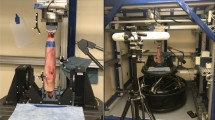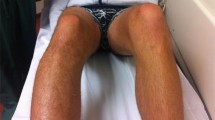Abstract
We present our technique for screw stabilization and our clinical experience treating a series of patients presenting with proximal tibiofibular joint fracture-dislocations.
Similar content being viewed by others
Avoid common mistakes on your manuscript.
Introduction
Proximal tibiofibular joint (PTFJ) dislocations are under-investigated injuries that are associated with high-energy lower extremity fractures [1]. The management of PTFJ dislocations spans closed management to reconstruction [2]. Proximal tibiofibular dislocations are rare injuries which accompany high-energy fractures of the proximal tibia. Instability of the proximal tibiofibular joint may result in persistent instability, lateral knee pain and common peroneal neuropathy [3,4,5]. Reduction and stabilization of PTFJ disruptions is a common treatment strategy for patients with ipsilateral lower extremity fractures.
PTFJ dislocations alter knee mechanics. A recent biomechanical study highlighted the impact of simulated PTFJ dislocations on knee mechanics [6]. Simulated dislocation of the PTFJ resulted in a pathologic increase in external rotation and anterior fibular translation. This pathologic motion is correctable with reduction and fixation. This article describes our treatment strategy for PTFJ dislocations associated with operatively managed proximal tibia fractures.
Surgical technique—extended anterolateral approach
Case #1
This patient presented after a motor vehicle collision with a type IIIA proximal tibial shaft fracture and a PTFJ dislocation. Initial management included I&D, and external fixation. Postoperative films, Fig. 1a, revealed persistent instability of the PTFJ. She was scheduled for ORIF of the proximal tibia and PTFJ.
(a–d) Case Example: Extensile lateral approach: (a) AP and lateral views confirming persistent fibular instability following external fixation (b) Intra-operative photo revealing the tibial contribution to the proximal tibiofibular joint (c) Freer elevator highlighting the proximity of the common peroneal nerve to fixation (d) Freer elevator placed under a crural septae which can tether the nerve (e) Final fixation construct
The patient was placed supine on a radiolucent operating table. The ipsilateral buttock was bumped and the leg was placed on a radiolucent ramp. An anterolateral approach to the proximal tibia was made down to the IT band and fascia of the anterior compartment. The proximal tibia fracture was reduced to assist reduction of the PTFJ.
The approach to PTFJ started proximally by identifying the common peroneal nerve (CPN). The nerve is reliably located posterior to the biceps femoris tendon. A neurolysis was performed by releasing the overlying fascia of the lateral compartment. The neurolysis included a release of the anterior and posterior crural intermuscular septa [7] The anterior septum was identified between the peroneus longus and extensor digitorum longus. The posterior crural intermuscular septum was identified by elevating the peroneus longus anteriorly and gently dissecting along the course of the nerve. The fascial band was released, freeing the nerve. Fig. 1b–d includes intra-operative photographs of common peroneal neurolysis.
Next, the PTFJ was approached and prepared for reduction. The joint was accessed between the anterior and lateral compartments. Dissection in this interval revealed the disrupted PTFJ including the cartilaginous surface of the tibial contribution to the joint (Fig. 1b).
Reduction was completed with manual manipulation of the proximal fibula. A thumb was placed on the fibular head to direct the reduction. This produced a palpable reduction and restored stability when reduced. The reduction was provisionally stabilized and final fixation performed with 3.5 mm screws under fluoroscopic guidance (Fig. 1e).
Surgical technique—direct lateral approach
Case #2
The second patient presented after a motorcycle collision with a tibial shaft fracture and an associated PTFJ dislocation. Fig. 2a includes biplanar views of the knee at presentation. Fixation with a plate-nail construct and ORIF of the PTFJ through a direct approach was planned.
(a–d) Case Example: Direct approach: (a)Proximal 1/3 tibial fracture with associated proximal tibiofibular joint dislocation (b) Persistent fibular instability following stabilization of tibia (c) Intra-operative photo demonstrating approach and fixation (d) Final fixation construct with reduced proximal tibiofibular joint
The patient was placed supine on a radiolucent operating room table. The ipsilateral flank was bumped and the leg was placed on a radiolucent ramp. The proximal tibia fracture was exposed, reduced and fixed with plate-nail construct. There was persistant instability of the PTFJ despite restoration of length, alingment and rotation of the tibia fracture (Fig. 2b).A freer was placed along the midpoint of the distal femur and proximal tibia to center an approach to the PTFJ. The skin and superficial tissues were incised to expose the distal iliotibial band. Careful dissection was used to expose the lateral knee structures. A CPN neurolysis was performed as previously described. The PTFJ was exposed, debrided, reduced and fixed with a single 3.5 cannulated screw as above Fig. 2d.
Figure 2d shows final anatomic reduction and fixation of the tibia and PTFJ.
Pitfalls
Stabilization of the PTFJ has several potential complications. The CPN must be identified and protected to avoid iatrogenic injury. Percutaneous fixation is not advised. Obtaining an anatomic reduction of the PTFJ is predicated on appropriate reduction of the tibial fracture. Correcting the length, alignment and rotation of the tibia aids reduction of the PTFJ. Preoperative external rotation views of the contralateral knee can help gauge a concentric reduction.
The PTFJ must be stabilized thoughtfully to avoid complication. First, the posterior neurovascular bundle is in jeopardy with aberrant instrumentation. A cranial and proximal aimed instrumentation parallels the articulation and avoids symptomatic instrumentation. Second, the PTFJ instrumentation should be placed after tibial instrumentation to avoid interference.
The PTFJ contributes to the posterior-lateral corner (PLC) but not to the same degree of the LCL, biceps femoris and other contributing structures. Consider fixation of associated soft tissue and bony injuries in conjunction with stabilization of the PTFJ.
Clinical series
A retrospective review was conducted to identify patients treated for PTFJ dislocation at a single trauma center. Eleven patients were treated with this technique over 20 months. All patients were men with a mean age of 44 years (22–59 years). Seven patients presented after vehicle collisions, three after auto vs pedestrian accidents and one after a fall from height. Four patients were smokers and one was diabetic. Eight patients presented with a tibiofibular dislocation associated with an ipsilateral tibial shaft fracture, two with an ipsilateral tibial plateau fracture and one patient had an isolated dislocation. Ninety percent presented with an open fracture and 45% had associated peroneal nerve palsy.
Eight patients were treated with one small fragment screw. The remaining were treated with two small fragment screws. Six patients were treated with an intramedullary nail, four treated with plate fixation for the ipsilateral tibial fracture. The patient with an isolated PTFJ dislocation was treated with screws alone.
The average follow-up was 485 days (365–810 days). Radiographic follow-up revealed intact instrumentation at time of ipsilateral fracture union in nine patients. Two patients had broken instrumentation. In these cases, the screw failed between 6 and 12 months postoperatively. Both patients were asymptomatic at final follow-up. There were no cases of instrumentation removal.
Discussion
PTFJ dislocations present after high-energy mechanisms. It is estimated that PTFJ injuries occur in 1–1.5% of tibial shaft fractures and 2% of tibial plateau fractures [1, 8]. We identified that eleven patients were treated with this technique and all achieved union of their ipsilateral tibial fracture and were asymptomatic at the PTFJ.
There is little evidence to direct treatment of PTFJ dislocations following high-energy trauma. Most recommendations relate to management of isolated sports injuries. Herzog et al. published the largest case series, 30 patients, of PTFJ injuries following high-energy trauma [1]. That study highlighted the incidence of this injury but did not discuss management.
The fibular head and PTFJ play a role in knee stability. Injury models of PTFJ disruptions reveal pathologic knee mechanics following injury. This instability is corrected with appropriate reduction and fixation [6]. We believe that surgical stabilization of the PTFJ improves knee stability following high-energy tibial fractures.
The PTFJ is a dynamic articulation which translates and rotates with physiologic motion. Cadaveric biomechanical studies revealed that proximal fibula translates 1–3 mm and externally rotates with ankle dorsiflexion and weightbearing [10,11,11]. As patients convalesce from their injuries, screw fatigue and failure are not unexpected and patients should be counseled about this possibility.
Conclusions
We describe a technique for restoring stability to the PTFJ using routine instrumentation. This technique was successfully used to treat 11 patients without complication. Until additional clinical evidence is developed, we recommend operative stabilization of these injuries in the setting of ipsilateral tibial fractures.
References
Herzog GA, Serrano-Riera R, Sagi HC (2015) Traumatic proximal tibiofibular dislocation: a marker of severely traumatized extremities. J Orthop Trauma 29(10):456–459
McNamara WJ, Matson AP, Mickelson DT et al (2018) Surgical management of proximal tibiofibular joint instability using an adjustable loop. Cortical Fixat Device Arthrosc Tech 7(3):e271–e277
Ogden JA (1972) Dislocation of the proximal fibula. Radiology 105(3):547–549
Ogden JA (1974) Subluxation and dislocation of the proximal tibiofibular joint. J Bone Joint Surg (Am) 56(1):145–154
Marchetti DC, Moatshe G, Phelps BM et al (2017) The proximal tibiofibular joint: a biomechanical analysis of the anterior and posterior ligamentous complexes. Am J Sports Med 45(8):1888–1892
Magnusson E, Parker K, Telfer S, et al. (2020) Traumatic proximal tibiofibular joint dislocations: fixation matters. OTA annual meeting
Humphreys DB, Novak CB, Mackinnon SE (2007) Patient outcome after common peroneal nerve decompression. J Neurosurg 107(2):314–318
Haupt S, Frima H, Sommer C (2016) Proximal tibiofibular joint dislocation associated with tibial shaft fractures—7 Cases. Injury 47(4):950–953
Ogden JA (1974) The anatomy and function of the proximal tibiofibular joint. Clin Orthop Relat Res 101:186–191
Bozkurt M, Yilmaz E, Atlihan DA et al (2003) The proximal tibiofibular joint. Clin Orthop Relat Res 406:136–140
Eichenblat M, Nathan H (1983) The proximal tibio fibular joint: an anatomical study with clinical and pathological considerations. Int Orthop 7(1):31–39
Funding
No Funding was provided for this study.
Author information
Authors and Affiliations
Contributions
EAM contributed to study design, data collection, data analysis and manuscript preparation. MFG/DPB contributed to manuscript preparation, editing. RF contributed to study design, manuscript preparation and editing.
Corresponding author
Ethics declarations
Conflict of interest
The authors declare no conflicts of interest.
Ethical approval
This study was cleared by the University of Washington Institutional Review Board.
Availability of data
Authors are willing to share de-identified data.
Additional information
Publisher's Note
Springer Nature remains neutral with regard to jurisdictional claims in published maps and institutional affiliations.
Rights and permissions
About this article
Cite this article
Magnusson, E.A., Githens, M.F., Barei, D.P. et al. Reduction and fixation of high-energy proximal tibiofibular joint dislocations: a technical trick. Eur J Orthop Surg Traumatol 32, 377–380 (2022). https://doi.org/10.1007/s00590-021-02911-7
Received:
Accepted:
Published:
Issue Date:
DOI: https://doi.org/10.1007/s00590-021-02911-7






